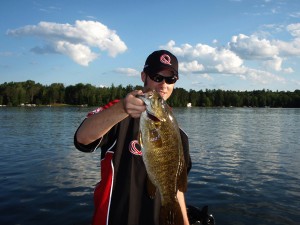The long and warm dog days of summer morph into the shorter, cooler and crisp days of early fall. Water temperatures on lakes that were once warm at 75 degrees begin to gradually plummet into the cool 60 degree range, triggering a transitional period feeding binge for all species of fish. Summertime recreational boat traffic and fishing pressure subsides, leaving many lakes open to anglers who are after some of the finest action of the season. This time of the year is one of my favorites for loading up on smallmouth bass. My favorite way to take advantage of this period is by fishing with suspending jerkbaits such as the Rapala X-Rap.
Nicknamed as the “smallmouth spectacular” by my friends and me, the X-Rap is an extreme action slash bait that was released in 2004. When Rapala introduced the X-Rap, they not only brought a great new lure to fishermen, but they introduced an entirely new fishing system that revolutionized the way anglers fish jerkbaits. The versatility of the X-Rap allows an angler to impart several different motions and actions in a single retrieve, and it triggers strikes when most other baits fall short. Of the dozens of baits and lure choices I can try for smallmouth bass, nothing rivals the effectiveness of an X-Rap.
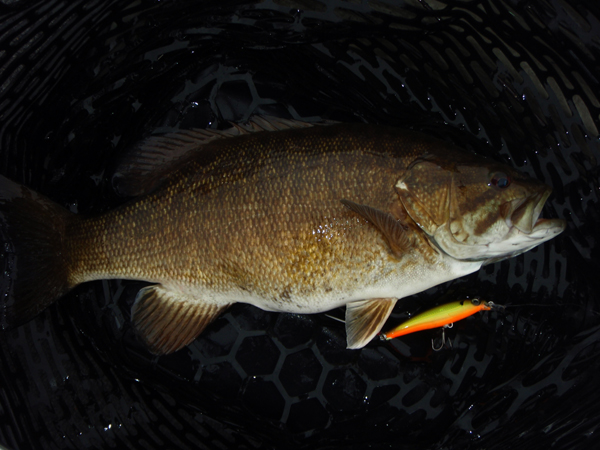
Smallmouth bass are peculiar predators, notorious for exhibiting curious behavior towards their environments and surroundings. At times they will sneak up to check out and sniff a lure. Sometimes they will completely ignore everything altogether. While other times, they will smash and crush moving baits and anything in sight. Anglers who are passionate about smallmouth bass fishing live for these magical moments when schools of fish transform into attack mode and feed on anything in sight.
For anglers who are as curious as smallmouth bass are, there are a few different factors that elicit this aggressive fish behavior. First, the days grow shorter and sunlight penetration decreases. This leads smallmouths to abandon their main lake deep water summertime locations, moving into shallower water where more food sources are present in areas with sunlight. Second, colder water temperatures make smallmouths switch their food preferences from crayfish to baitfish, which requires aggressive feeding. Lastly, water temperatures begin to cool. Water temperatures that gradually fall from the 70’s into the 50’s triggers aggressive feeding for all species of fish. This is a sign for smallmouths that winter is on its way and forage species will no longer be in abundance. With the conditions and seasons changing, smallmouths realize it’s time for them to eat.
During the summer to fall transitional period, there are two ways to go about and catch smallmouth bass with X-Raps. I like to fish for structured fish and suspended fish.
Structured Smallies

X-Rap smallmouths are best fished around shallow structure when water temperatures are in the range of 56 to 70 degrees. At midday, when sunlight peaks, smallmouth bass can be found in their classic summer locations. Fish disperse and feed heavily on both crayfish and structure-oriented baitfish in relatively shallow water on main-lake structures such as rock bars, points, and drop-offs in depths of 6 to 15 feet. In addition, fish may even be in the extreme shallows feeding near downed wood cover and piers.
Smallmouth bass that are situated in shallow and mid-depth ranges are known to be most aggressive, and clearly exhibit their competitive nature. These fish tend to ambush and feed in groups of up to half a dozen fish. When hooked, it is a common occurrence to have followers trailing behind, attempting to steal the bait. Structure oriented smallmouths are the fish I prefer targeting most often. When they’re aggressively feeding and showing interest in the X-Rap it’s a guaranteed bite.
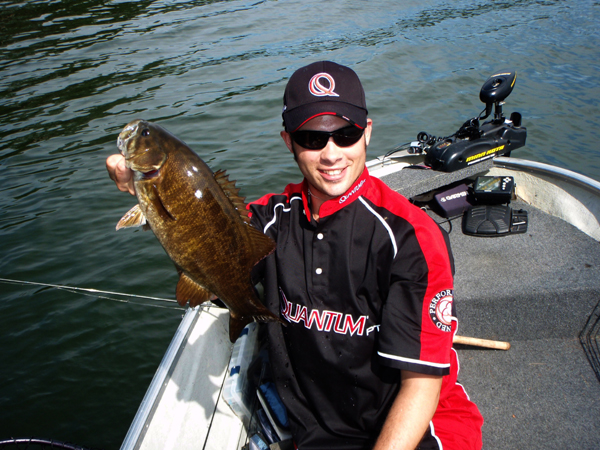
When smallmouths are located in the shallows, and can be seen in the water feeding and traveling in their packs, the best way to fish an X-Rap is to be as aggressive as possible. I make long casts so as not to spook the fish, and use erratic retrieves with frequent jerks. Fish will usually strike on the pause.
I have observed that when fish are located near structure, they will make frequent trips into shallower or deeper water if necessary. Therefore, it is important to make adjustments along the way in terms of boat positioning and casting angles. I’ve had some of my best and most epic days of X-Rap structure fishing during windy conditions by following the windblown shorelines. However, if fish are showing signs of aggression then they can be caught in nearly all conditions.
Suspended Smallies
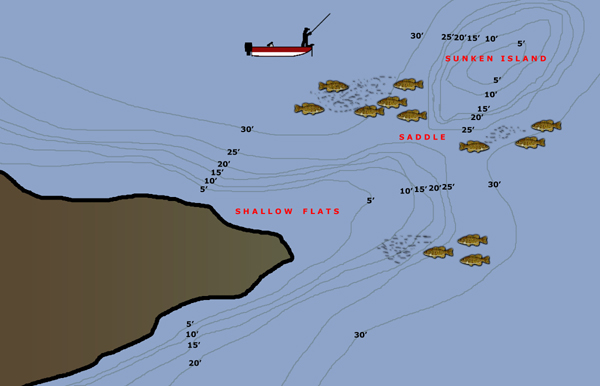
In the autumn, usually when water temperatures drop to below 58 degrees, majority of the smallmouth will begin suspending off structure in lakes where they aren’t feeding predominantly on forage species in shallow water. Most of my fishing for suspended smallmouths occurs in depths ranging from 15 to 40 feet.
On most of my good smallmouth lakes, I focus on the same main-lake structures that fish have been using for most of the summer. A long shallow sand point that extends out into deeper water and has rocks and boulders lined along the bottom near the drop-off is a perfect example. One of the best places anyone can begin fishing for suspenders are breaks that drop quickly into deep water.
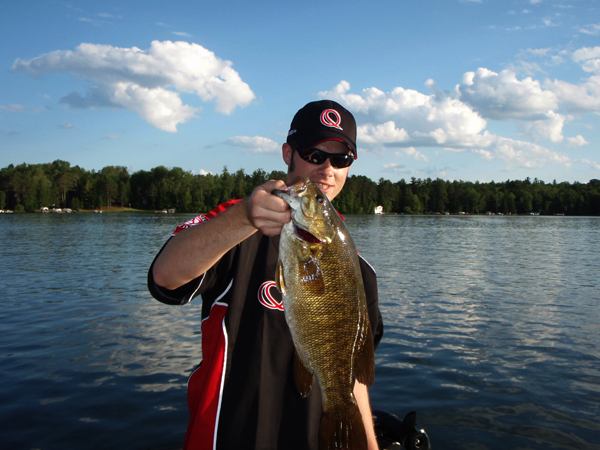
Finding suspended fish can be difficult, but using the right tools simplifies the process. The best way I locate smallmouths is by using my boat’s electronics and frequently scanning the water column. Besides electronics, another good method to finding fish is observing the water as the sight of surfacing baitfish signifies the nearby presence of smallmouths.
Usually smallmouths will be in groups, hovering beneath schools of baitfish and ambushing them from unsuspecting angles. In this situation my favorite way to fish the X-Rap is to make long casts in the direction of the baitfish. The retrieve will often be painfully slow, with long pauses allowing for the lure to fall at the depths baitfish are suspended. The occasional jerk with the long pause portrays an injured minnow within the school, which often triggers smallmouths into biting.
Techniques
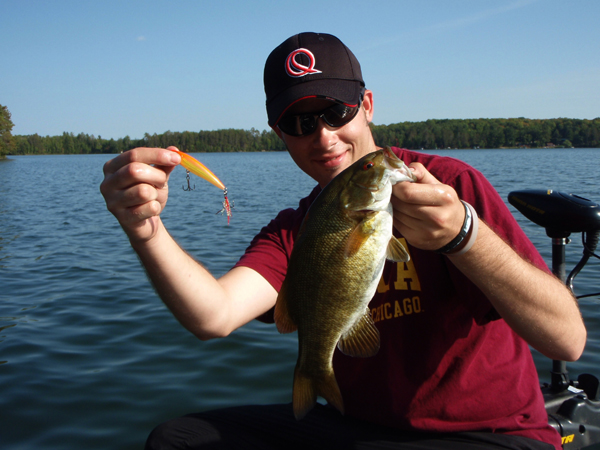
Due to its slender profile and strong construction, the X-Rap is built for accurate, long distance casting. The X-Rap incorporates a long-cast design, enabling weights to shift during the cast. Its weight-forward design is a benefit because it allows anglers to cover vast amounts of water quickly, making it an effective search bait.
The key characteristic of the X-Rap is that it can be fished in any type of manner and according to the moods and feeding patterns of the fish. This correlates with the retrieve of the X-Rap and the way it is fished as it involves a lot of mixing and matching according to the behavior of the fish.
My success with the X-Rap is always dictated by the activity and aggression levels of the fish. For instance, on days when smallmouths are active and striking everything in sight, I prefer retrieving the X-Rap with an erratic hard wrist twitching and rod ripping motion. In this situation the rod tip is pointed down towards the water and I employ a rapid erratic rip-pull-rip motion through the water. After a series of 3 to 5 rips, I allow the lure to pause for a second before resuming the motions again. Another tactic that works well is the sweep retrieve. This is similar to the hard twitching retrieve but instead of rapid erratic jerks I use longer, more powerful jerks with slightly longer pauses.
On some days there are occasions where smallmouths are in negative moods. These scenarios occur during cold fronts, early mornings when daily water temperatures are at their coldest, and on calm sunny afternoons. In these situations I significantly slow down my rate of retrieve by making long casts coupled with long pauses. Sometimes dead sticking the X-Rap is required to elicit strikes from smallmouths. It is important to note that this style of retrieve works well in other adverse conditions such as when fish are suspending in open water.
There are many other great methods for fishing the X-Rap. However, the best retrieve is one where the angler can be creative and form an aggressive retrieve that is based according to the behavior of the fish.
In addition to retrieve, another important factor leading to success is that this style of fishing is very visual. The majority of my strikes are often seen in the water through the aid of polarized sunglasses. Having a keen eye on the suspending jerkbait being retrieved through the water and reacting quickly to smallmouths when they are seen ambushing the lure leads to increased catch rates.
Gear and Color Styles
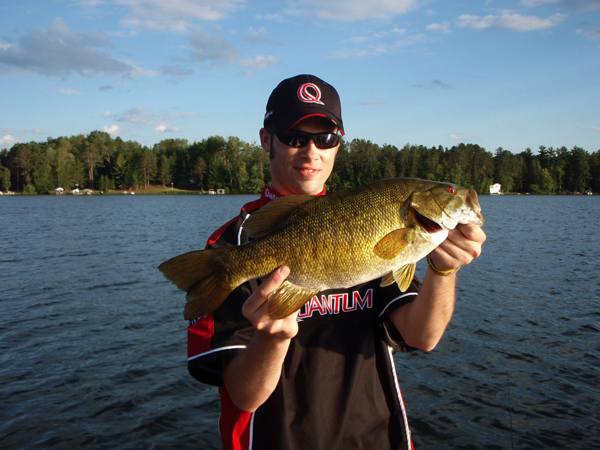
In order to successfully fish X-Raps, spinning rods with a lot of power and sensitivity are important. One of the big questions I’m often asked by anglers is whether to use braided lines or easy casting copolymers. According to Rapala’s website and some known tournament anglers, X-Raps are suggested to be fished with braided superlines due to their strength and abilities to cast for longer distances. Although these are good characteristics, braided lines are poor for fishing an extreme action slashbait like the X-Rap. They are bad at absorbing shock from the powerful hook sets needed, and they impair the lure’s action during the retrieve by a significant amount. In addition, they float which is a poor characteristic for a bait that is fished best while suspended. With all that being said, I recommend easy casting copolymers.
I very rarely use baitcasting equipment with X-Raps because it impairs casting distance and action. For all of my X-Rap fishing, I prefer using 7 foot medium or medium heavy fast action spinning rods with size 30 reels. The rods must have a strong backbone and a lot of sensitivity for maximizing the bait’s action and feeling any subtle strikes from fish. The rod I exclusively use for this style of fishing is a 7 foot Quantum Tour Edition that is paired up with a size 30 Quantum Catalyst. This reel is the perfect size for long accurate casts because it holds up to 200 yards of either 8 lb. P-Line Evolution or Cortland Endurance. Both are easy casting and abrasion-resistant copolymer lines.
One last question facing anglers are sizes and color styles. I typically fish with the XR8 which is a ¼ oz. lure at over 3 inches long that reaches depths of 3 to 5 feet on the average retrieve. This is a good all-around size for catching both numbers and sizes of fish. I use it year-round. In addition, I sometimes increase the size to a 4 inch XR10, but I only do this in late fall when bigger smallmouths are present.
As far as color styles are concerned, the X-Rap is available in 19 different colors. Since smallmouths often feed by sight, I’ve had my best success using the brightest, most obnoxious colors that I can get away with. My favorite is “Hot Head,” a fluorescent orange/yellow color combination that drives the fish wild. Other noteworthy colors that I have had excellent success with are “Rusty Crawdad”, “Clown”, “Copperhead”, and “Moss Chartreuse Shad”. These bright colors are typically used in depths shallower than 15 feet, especially when fish are on structure.



Traditional wisdom suggests that these bright colors should only be used in waters with reduced clarity. Unfortunately I break the rules of the bass fishing color barrier. Over the years I’ve learned that these bright colors have little effect on the fish in lakes with the clearest water clarity. The erratic action of the retrieve along with its bright color actually attracts fish from a distance and entices them into striking more often than using something that looks more natural and matches the hatch. The only situation where I would use naturalistic colors is when fishing for suspended smallmouths later in the fall, and especially when it’s entirely a baitfish bite. Preferred colors for suspended smallmouths are “Moss Black Shiner”, “Glass Ghost”, “Olive Green”, and “Perch”.



I’m often told by anglers that fishing with the X-Rap requires little skill, and the bait will catch fish regardless of color and retrieve being used. I’ve fished head-to-head against others by utilizing different color schemes and retrieves, yet casting at the same angles, and I have always come out on top by outfishing them. When fishing the X-Rap, presentation is everything, and the way you approach the fish and adapt to their behaviors and interests truly makes a difference between success or failure.
In summer of 2005, I tied on my first ever X-Rap. In recent years I have been able to experience this phenomenon of fast action smallmouth bass fishing on almost every lake I fish. Nowadays, I always keep a rod tied up with a size-8 X-Rap so that I can take advantage of these feeding periods during the summer to fall transition. With all this success and the possibilities for big fish, who wouldn’t want to do the same?
